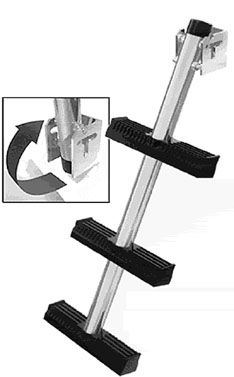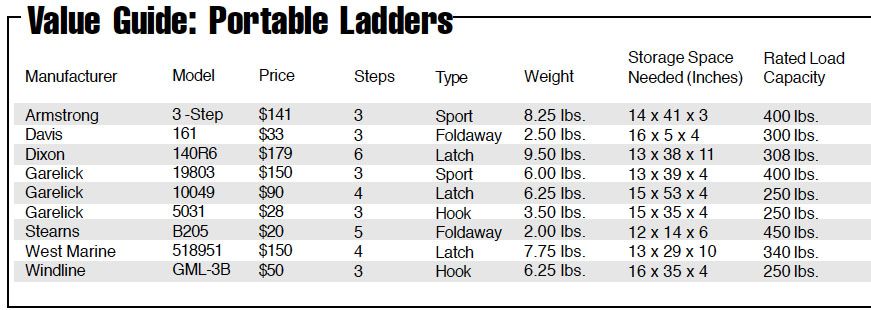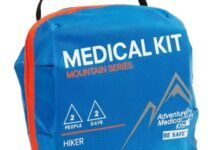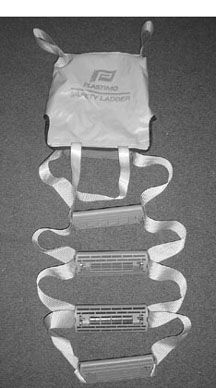One of the brightest design features on many of today’s production boats is the boarding transom, which not only helps people step aboard easily from dock or dinghy, but often provides space for terminating backstays, storing man-overboard gear, shower and wash-down facilities, and, of particular interest here, boarding ladders. These are usually permanently mounted fold-down ladders that make swimming off the boat easy and convenient, and serve as vital safety features in a man-overboard situation.
Boats that don’t have these handy transom arrangements still have a variety of ladder options available. They can range from dockline with a couple of loops tied in it for foot-holds, draped over the side, to beautifully engineered stainless steel fold-up ladders that stow against the stern pulpit or lifelines, ready to be lowered away on permanent pivots. On most standard-transomed cruising boats, however, the ladder is a fold-up affair that lives in the cockpit locker, and usually ends up so reeved with odds and ends of line that it looks like a loom and can’t be withdrawn from the locker without foul language.
This past summer we joined our colleagues at Powerboat Reports for an evaluation of these removable ladders. Inconveniences of stowage aside, we wanted to find out which seemed the best-built, sturdiest, and most comfortable to climb. (Bear in mind that this was perhaps more a consideration of ladder types than of individual products: There are so many variations, even in one manufacturer’s line, that it would be impossible to cover them all.)
Even before taking you to the report, we can say that for sheer sturdiness and safer, easier climbing from the water, we prefer latch ladders with “over the gunwale” configurations: That is, ladders with hooks that loop high over the rail and lock securely into keyhole brackets, and that have stand-offs to keep them away from the hull, thus providing space for toes and fingers to grip the rungs.

On any good boarding ladder, assuming there’s a rung at or near the water’s surface, there should be two steps submerged below it. An older or less athletic person will very likely not be able to manage with just one below. Similarly, it’s very difficult for a non-athletic person to climb up a collapsible rope ladder, especially on a boat with relatively low freeboard, where the rope ladder inevitably follows the turn of the bilge under the boat, thereby making it a real upper-body workout. In fact, keeping a rope ladder aboard “for emergency use” is perhaps not the best idea. In an emergency, you would want the sturdiest, easiest-to-climb ladder in the world. You’d save the rope ladder for the balmy swimming days after a full season of pull-ups.
What We Tested
We tested nine boarding ladders ranging in price from $20 to more than $250. Seven manufacturers participated in testing, with four distinct types of ladders comprising the field: sport, latch, hook and foldaway. Sport ladders have a single, central support bar from which steps project, and they require a separate transom bracket. Latch types require two small keyhole brackets to be installed on deck. The two other types, the free-standing hook ladders and rope-based folding ladders, are more familiar. None is permanently mounted to the vessel and all are removable for stowage aboard.
Garelick supplied three ladders for our evaluation, a 19803 3-step aluminum sport ladder, a 10049 4-step latch ladder, and a 5031 3-step hook ladder. Armstrong provided its 3-step stainless steel sport ladder, while both Dixon and West Marine sent along some welded stainless steel latch ladders: a 6-step 140R6 and a 4-step 518951, respectively. Windline was represented with its GML-3B 3-step hook ladder. Two companies supplied plastic foldaway ladders—Davis’ 3-step and Stearns’ 5-step.
Initially we thought we would simply exclude the results for the sport ladders, which are targeted at divers and snorkelers boarding low-transomed powerboats—but the ladders behaved so well that we began to think of some sailboats and sailing situations where they’d work just fine. So we kept them in.
Testing and Rating
Each ladder was rated for ease of installation and given a score, 1 being the most difficult to install and 4 the easiest.
Each time these ladders are needed, they must be moved from their storage area and fastened to the vessel. This is one part of our ease-of- installation score. The other portion is based on the permanent installation of brackets used to hold the ladder. If a ladder had no permanent mounting but simply needed to be unfolded, it was rated easy to install. However, if a ladder required a difficult, even though one-time, installation of permanent hardware it was rated as most difficult to install.
Once ladders were installed on a boat (our test boats were high- and low-freeboard powerboats), they were rated for ease of use. This rating was derived after having several testers from a 60-lb. child to a 250-lb. adult climb each ladder a number of times and evaluate its usability.
Anyone who has ever used a removable boarding ladder has at one time or another forgotten to remove the ladder before getting underway. So we devised a side-load test to see what would happen to each ladder under this circumstance. With each ladder installed, our test boat was moved ahead at about 5 knots for 15 seconds. If a ladder did not move, it was rated highly (4). If, in our opinion, a ladder appeared to be on the verge of going overboard with any increase in speed, we rated it poorly (1).
To determine the bottom line, we also took into consideration the product’s cost, quality of construction, weight, and required storage space.
Armstrong 3-Step Sport
This is a well-constructed 3-step stainless steel centerpost sport ladder that mounts on a bracket. A fixed bracket is generally through-bolted to the transom of the boat, as was the case with our test boat. There is optional hardware that allows mounting this ladder to a swim platform. This ladder comes with the bracket and a plastic hold-down lock, as well as plastic brackets designed to hold the ladder to a bulkhead when not in use. Once the mounting bracket is permanently installed, using the ladder is easy: Simply slide the ladder into the bracket and lock it in place.

Our testers liked the ladder, saying it was easy to climb and very stable. Divers will love this ladder as it allows you to climb the first few steps with your swim fins still on your feet. The downside to this and other sport ladders is the installation of the bracket. It requires large holes drilled near the waterline in the transom. It is essential that these holes be properly sealed during installation. If you’re not handy around boats, have a pro do it.
Bottom Line: This sport ladder is certainly not cheap at over $140. But it’s built to last, easy to use, and it floats, though sometimes vertically.
Davis 161
This foldaway ladder, which comes unassembled, is built with plastic steps and polypropylene rope rails. It uses plastic pipe over the rope to maintain the distance between the steps. Assembly is easy and only took a few minutes. The whole ladder can then be stored in a supplied plastic bag.
The ladder must be attached to a cleat or stanchion capable of taking the load. Even on a test boat with low freeboard our testers didn’t like climbing it. It moves around too much and can pinch fingers and toes between the ladder steps and the boat. One tester couldn’t get into the boat at all using this ladder.
Bottom Line: This ladder is difficult to climb, like the Stearns foldaway, and it sinks. However, it’s cheap, and stows away small.
Dixon 140R6
This is a 6-step welded stainless steel folding latch ladder, with a pair of vertically folding stand-offs. The ladder comes assembled but does require the installation of two keyhole brackets on your boat. The supplied brackets use four small screws and require only a minimum of mechanical skill to install. To use, the stand-offs are folded down and the ladder is clipped into the keyhole brackets. You can unfold it before or after clipping it to the brackets. Our testers found this ladder fairly easy to climb, though some mentioned its narrowness. Some flexing was also noted; however, in fairness, this was the longest ladder tested and we expected some flexing. On the side-load test, this ladder was rated fair, as it popped out of the forward bracket, turned about 30 degrees and hung on by the aft bracket. Should it pop off both brackets, it would be gone, as it sinks quickly.
Bottom Line: This is a good ladder. We’d like to see slightly heavier stainless construction in the longer ladder sizes (but no increase in price, of course).
Garelick 19803
This is a high-quality 3-step aluminum center post sport ladder that mounts on a bracket. We tested this ladder in the same bracket as the Armstrong due to the difficulty of installing a second bracket on our test boat. Its supplied bracket is of high quality and comparable to the bracket used for testing. All the comments made about the Armstrong apply to this ladder as well.
Bottom Line: We like this ladder a whisker better than the Armstrong because it’s 25% lighter and it always floats horizontally in the water, making it a large target if lost.
Garelick 10049
This 4-step aluminum and plastic latch ladder came partially assembled, requiring us to install the stand-offs. Like the other latch ladders, it requires keyhole brackets, which were not supplied.
This ladder is marketed as a latch ladder. However, in our opinion, it is a hybrid—something between a latch ladder and a hook ladder. Like a latch ladder, it does require keyhole brackets. Our testers found this ladder to be far less stable than other latch ladders tested and more comparable to hook ladders while climbing. Therefore, they rated it fair for usability.
On the side-load test, this Garelick 10049 folded back at a 45-degree angle and stayed attached, which earned it a good rating.
Bottom Line: This ladder carries all the downsides of a latch ladder: it’s expensive, requires latch installation, and uses lots of storage space. However, it doesn’t have a latch ladder’s strong points, like stability and ease of climbing.
Garelick 5031
This 3-step aluminum and plastic gunwale hook ladder came fully assembled and ready for use. You simply unfold the arms and stand-offs and hook it on the gunwale. Our testers rated this ladder only fair in usability; it’s harder to climb than a sport or latch ladder.
On the side-load test, this ladder was nearly pulled off the boat.
Bottom Line: The good news is that it’s light, tough, simple, cheap, and it floats. If you don’t want to spend a lot, and don’t use your ladder a lot (and are in decent physical shape) this would do fine.
Stearns B205
This 5-step foldaway model came assembled and ready for use. It’s constructed with plastic steps and nylon rope rails. The Stearns B205 utilizes plastic pipe over the rope rails to maintain the distance between each step. Like the Davis foldaway, this ladder must be attached to a cleat or stanchion. An ad for this ladder claims, “As weight is applied, the rungs become stiffer.” Our testers did not find this to be the case, but rather found this ladder just as difficult to climb as the Davis foldaway.
Bottom Line: This was the least expensive ladder in the bunch. If you subscribe to the idea of keeping a rope ladder as a back-up, you could make do with it.
West Marine 518951
This is a 4-step welded stainless steel folding latch ladder, with plastic padded steps and a pair of folding stand-offs. Like the Dixon latch ladder, the West Marine unit comes assembled, but does require the installation of two keyhole brackets. The supplied brackets use two small screws each for attachment and require minimal mechanical skill. The stand-offs fold down, and the ladder is clipped into the keyhole brackets. It can be unfolded to full length before or after being placed in the keyhole brackets.
Our testers found this model fairly easy to climb, though they noted that it was fairly narrow. Our testers liked the padded steps. In the side-load test, it vibrated for several seconds then popped out of one bracket but remained attached to the boat. Like the Dixon, this ladder will sink if it pops out of both brackets.
Bottom Line: The West ladder is much the same as the Dixon, with the addition of padding on the steps. The West model we looked at had two fewer steps than the Dixon, and costs $29 less. (That would make a step worth $14.50. Hmmm. Never knew that.) The West is perhaps more convenient to buy in the US. In any case, for latch ladders it’s a toss-up.
Windline GML-3B
The Windline GML-3B, a 3-step stainless steel and plastic gunwale hook ladder, came fully assembled and ready for use. It operates in the same fashion as the Garelick hook ladder. However, it requires much more effort to unfold the arms. The upside to this is added stiffness and stability during use. As with the Garelick hook ladder, our testers rated this ladder fair in usability; even with its added stiffness, it’s harder to climb than a sport or latch ladder. It hardly moved in the side-load test.
Bottom Line: This ladder is heavier and certainly more stable than the Garelick hook ladder—but at nearly twice the price. We don’t think the benefits are worth the added expense.
Conclusions
Proper ladder fit and location will vary boat to boat. Remember, you need two full steps below the water’s surface. You also need to consider your stowage space, frequency of use, and type of use. If you’re a diver, and have a transom where a sport ladder bracket can be mounted conveniently, we see no reason not to consider one from Garelick or Armstrong. Otherwise, for frequent swimmers, we’d recommend a stainless steel latch ladder from Dixon or West Marine.
If you have a small boat and only carry a ladder for occasional use, and can’t justify the expense of a latch ladder, try a Garelick hook ladder. Note that while we didn’t rate the Windline hook as highly as the Garelick, Windline makes a wide range of other ladders worth consideration.

Armstrong Nautical Products, 800/226-7204, www.armstrongnautical.com.
Davis Instruments 510/732-9229, www.davisnet.com.
Dixon Marine Products, 011 64 9 425 8831, www.dixon.co.nz.
Garelick Mfg. Co., 651/459-9795, www.garelick.com.
Plastimo USA, 866/383-1888, www.plastimousa.com.
Stearns Inc., 800/333-1179, www.stearnsinc.com.
West Marine, 800/BOATING, www.westmarine.com.
Windline Inc., 310/516-9812, www.windline.com.






































Thanks for your article! This guide addressed my concerns in choosing the right boat ladder for me and was able to allow me to make a well-informed decision. 🙂
A 3 rung ladder may be too short as pontoon ladders, but it might just be the right length for fishing boat ladders. On the other hand, a 5 rung ladder might be good for a swim platform but might be too long as a ladder for boarding. Getting the right number of steps is also important. 🙂